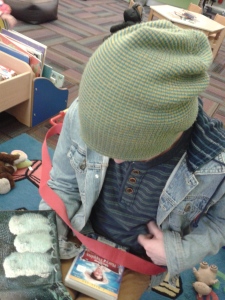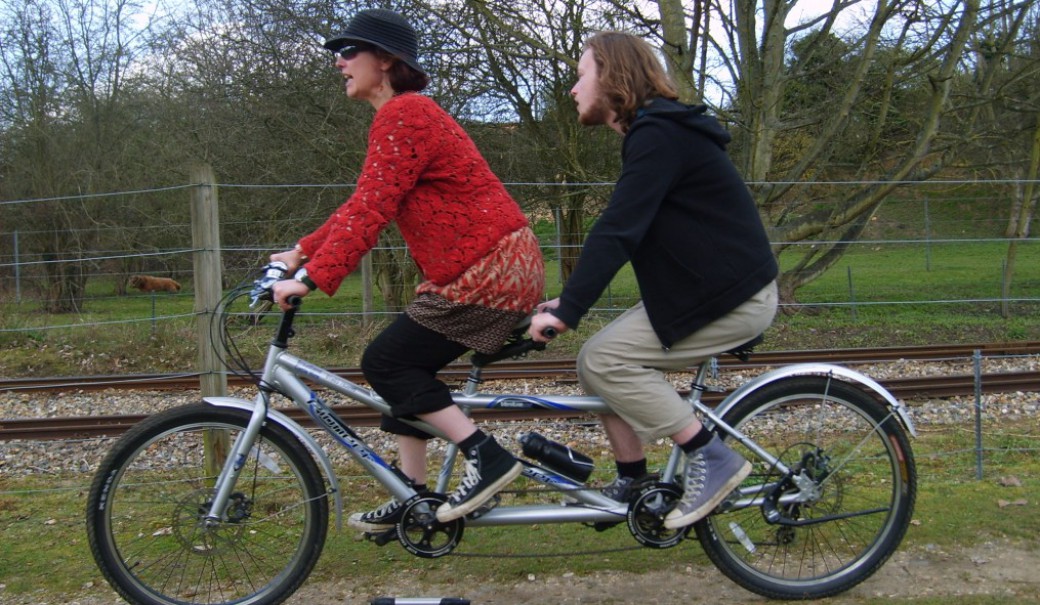 I’ve been wanting to write about accessibility for a while but have hesitated because ‘Tinc’ (who blogs at Tincture of Museum) already does it brilliantly. Tinc is well-qualified to do so; having resigned a career as a librarian to spend more time with her family (which includes a daughter with Aspergers) she now supports a variety of museums as a volunteer and blogger.
I’ve been wanting to write about accessibility for a while but have hesitated because ‘Tinc’ (who blogs at Tincture of Museum) already does it brilliantly. Tinc is well-qualified to do so; having resigned a career as a librarian to spend more time with her family (which includes a daughter with Aspergers) she now supports a variety of museums as a volunteer and blogger.
Tinc focuses on a range of issues of interest to museologists but her personal experience of autism means that she has particular insight into the ways in which museums can improve accessibility for visitors who are autistic (see for example her post about the London Science Museum). After Tinc generously tagged me in a round-up of blogs on museums and autism I thought I’d offer some reflections on Dylan’s experience of accessing the arts. In this piece I explore the terms ‘autism friendly’, ‘inclusive’ and ‘relaxed’ in relation to a range of artforms and organisations. There doesn’t seem to be agreement, within or across sectors, about the various terms used by organisations so the sense I make of these definitions is my own, based on personal experience. I make only brief reference to museums, however, and refer anyone with a particular interest in that sector to Tinc 🙂
Definitions
 If I encounter the term ‘Autism-Friendly’ I assume adjustments have been made to a venue or event with specific reference to the needs of autistic visitors. Such adjustments could include the selection of material; trained staff; adaptations to the environment to reduce sensory stimuli; changes to the timing and sequencing of an event; production of autism-specific resources; or ring-fencing of places to the autism community.
If I encounter the term ‘Autism-Friendly’ I assume adjustments have been made to a venue or event with specific reference to the needs of autistic visitors. Such adjustments could include the selection of material; trained staff; adaptations to the environment to reduce sensory stimuli; changes to the timing and sequencing of an event; production of autism-specific resources; or ring-fencing of places to the autism community.
An event advertised as ‘Inclusive’ may also include adjustments to the environment and scheduling of an event; while these are often helpful in relation to autism, such events are not developed specifically for autistic visitors but aim to improve accessibility for all disabled visitors. I’ve encountered the term ‘Relaxed’, meanwhile, in relation to live theatre performance. My experience was that the event did not incorporate significant adjustments to the environment. At relaxed performances, however, the audience is not required to adhere to the usual conventions (for example being silent) and audience participation is encouraged. I suggest that not only are such events not autism-specific, some of their features may be challenging for some people with ASC.
Managing without adjustments: libraries and art galleries
 Of course not everyone who is autistic requires adjustments in order to access ‘the arts’. Even with severe autism and a language and learning disability, Dylan manages perfectly well without adaptations in some settings. Libraries, for example, are fine; in fact they are one of Dylan’s favourite places and a regular fixture on his weekly schedule. It might be more of an issue if Dylan needed to access the adult section of a library but the material he is interested in is located in the children’s section which tends to be less formal.That’s not to say issues don’t arise: he has had to learn not to remove library labels from books and to accept that an item he wants might have been borrowed by another library-user. These are reasonable lessons, however, rather than accessibility issues.
Of course not everyone who is autistic requires adjustments in order to access ‘the arts’. Even with severe autism and a language and learning disability, Dylan manages perfectly well without adaptations in some settings. Libraries, for example, are fine; in fact they are one of Dylan’s favourite places and a regular fixture on his weekly schedule. It might be more of an issue if Dylan needed to access the adult section of a library but the material he is interested in is located in the children’s section which tends to be less formal.That’s not to say issues don’t arise: he has had to learn not to remove library labels from books and to accept that an item he wants might have been borrowed by another library-user. These are reasonable lessons, however, rather than accessibility issues.
 Because Dylan doesn’t read or write his interest in books is based on his love of illustration. Dylan’s strong orientation to the visual world means that art galleries are also of interest to him and, as with libraries, he manages these without adjustment. Although Dylan negotiates the space idiosyncratically, no adaptations are needed. Dylan has had to learn not to touch and to accept that if other people are looking then he will have to wait; equally he knows that if he stands too long before a painting I will encourage him to move on. But, again, these are reasonable things for Dylan to learn. I don’t think I’ve ever seen an art gallery advertise ‘inclusive’ viewings and I don’t think this is something Dylan needs. I do sometimes wish, however, that separate sessions could be scheduled for those who look askance at Dylan for being vocal or for moving quick, quick, slow.
Because Dylan doesn’t read or write his interest in books is based on his love of illustration. Dylan’s strong orientation to the visual world means that art galleries are also of interest to him and, as with libraries, he manages these without adjustment. Although Dylan negotiates the space idiosyncratically, no adaptations are needed. Dylan has had to learn not to touch and to accept that if other people are looking then he will have to wait; equally he knows that if he stands too long before a painting I will encourage him to move on. But, again, these are reasonable things for Dylan to learn. I don’t think I’ve ever seen an art gallery advertise ‘inclusive’ viewings and I don’t think this is something Dylan needs. I do sometimes wish, however, that separate sessions could be scheduled for those who look askance at Dylan for being vocal or for moving quick, quick, slow.
Understanding adjustments: managing museums
Although, as the blogs showcased by Tinc illustrate, some museums have become accessibility trailblazers, Dylan has so far managed without adjustments; this is not because he wouldn’t benefit from autism-friendly sessions but because I haven’t as yet been able to visit (these are mostly offered by the London museums). Although there are aspects of museums which Dylan finds challenging he copes pretty well. We make regular visits to local museums and, as with art galleries, Dylan has favourite exhibits. In the Millennium Galleries it is ‘cutlery dragon’ and at Weston Park Museum it’s the Polar Bear, the leaf-cutting ant colony and some local landscapes and portraits. Dylan often performs ritual greetings with his favourite exhibits; in front of Bear’s display cabinet, for example, he repeatedly charges a nearby whale harpoon.
The above examples illustrate Dylan’s preference for natural history and art. He also enjoys machines, particularly those involving steam, so local museums linked to our area’s industrial history are popular. Dylan tends to have less interest in social history unless there is something about the presentation which captures his attention; he loves the carriage ride around a Viking village at Yorvik Museum, I suspect, because the reconstruction feels like a movie set.
What Dylan needs when he visits museums is understanding as much as adjustment; at Yorvik for example it takes him a little while to get in and out of the carriage and he needs help to turn off the audio information. Ideally, we need to ride in our own carriage (and have been able to except for at very busy times). Dylan usually gets this sort of understanding in bucket loads from staff at museums. Although members of the public are also usually understanding, if Dylan experiences an obstacle it does tend to involve other visitors. Although this is sometimes because Dylan’s presence unsettles a member of the public, it is more often the other way around. Perhaps one of the key benefits of autism-friendly initiatives is that they offer autistic visitors a bit of time with the museum to themselves.
Inclusive cinema
 Sometimes an adjusted setting can be a stepping stone to a regular setting and I have used inclusive cinema screenings for this purpose with great success. Dylan has been passionate about film since he was young but because his habit is to watch alone the cinema did not appear to be an option; after various attempts to take Dylan ended in failure I gave up. The introduction of monthly ‘inclusive screenings’ at a local cinema, however, offered me the confidence to try again.
Sometimes an adjusted setting can be a stepping stone to a regular setting and I have used inclusive cinema screenings for this purpose with great success. Dylan has been passionate about film since he was young but because his habit is to watch alone the cinema did not appear to be an option; after various attempts to take Dylan ended in failure I gave up. The introduction of monthly ‘inclusive screenings’ at a local cinema, however, offered me the confidence to try again.
The first inclusive film we attended was one of the Harry Potter films. Although there were still some challenges for Dylan, leaving the lights on low (rather than viewing in complete darkness) and lowering the sound were adjustments which seemed to make him more comfortable. It helped that it was a film which Dylan knew – and it certainly helped me to know that people would understand if we needed to leave. But, I told myself, I might not feel the need to leave if Dylan was noisy as he wouldn’t, presumably, be the only one. When he stayed in the auditorium until the end of the film that day it felt like my best birthday ever (it was my 50th).
 Having spent the last four years taking Dylan to inclusive cinema he is now able to access regular screenings. The first time I tried this it was motivated by self-interest: The Borrowers had just been released and I wanted to see it. It was half term and the cinema was full with school children. I’d managed to get Dylan’s preferred row and seat (right hand side, four from the back, far aisle) but I felt hemmed in and anxious as the trailers started. Luckily it was a Studio Ghibli production which I think helped Dylan through an unfamiliar film in darkness with surround sound and chattering children. At inclusive cinema screenings I had been modelling appropriate behaviour, encouraging sit and ‘sshussh’. It turned out I had coached Dylan well; he pointed to a noisy child seated nearby and said ‘shouting! sshussh!’.
Having spent the last four years taking Dylan to inclusive cinema he is now able to access regular screenings. The first time I tried this it was motivated by self-interest: The Borrowers had just been released and I wanted to see it. It was half term and the cinema was full with school children. I’d managed to get Dylan’s preferred row and seat (right hand side, four from the back, far aisle) but I felt hemmed in and anxious as the trailers started. Luckily it was a Studio Ghibli production which I think helped Dylan through an unfamiliar film in darkness with surround sound and chattering children. At inclusive cinema screenings I had been modelling appropriate behaviour, encouraging sit and ‘sshussh’. It turned out I had coached Dylan well; he pointed to a noisy child seated nearby and said ‘shouting! sshussh!’.
Since then we have been frequent visitors at a range of cinemas. Some trips have been more successful than others and I don’t ever quite relax; I have to stay alert to Dylan’s impact on others as well as to how comfortable he is. One of the things Dylan always does at the end of a film is run to the front and sprint from side to side of the auditorium repeatedly. It is a stim, triggered by the rolling credits which he loves (at home, with no space to run, he flaps instead). At busy regular screenings – especially when there are small children – I have to manage the timing of Dylan’s run to the front (if people haven’t noticed there is anything different about us, this blows our cover). And because this can be quite stressful, we still go to (and prefer) inclusive cinema.
Relaxed Theatre
 One experience which has not been a stepping stone to mainstream events was a ‘relaxed performance’ of Peter Pan at the RSC in Stratford-Upon-Avon last year. Having had some positive experiences of accessibility initiatives an advert for the production caught my eye. Dylan is a serious fan of Peter Pan and it seemed a wonderful opportunity. I loved the idea of being able to take Dylan to the RSC in the same way that I might take my daughter; this was my dream of inclusion.
One experience which has not been a stepping stone to mainstream events was a ‘relaxed performance’ of Peter Pan at the RSC in Stratford-Upon-Avon last year. Having had some positive experiences of accessibility initiatives an advert for the production caught my eye. Dylan is a serious fan of Peter Pan and it seemed a wonderful opportunity. I loved the idea of being able to take Dylan to the RSC in the same way that I might take my daughter; this was my dream of inclusion.
So, with friends, I booked tickets for a matinee performance. Dylan and Ella coped with the production but it was challenging for Dylan. The performance did not appear to have been significantly adjusted in terms of, for example, lighting or sound and there weren’t any obvious time-out areas. The play was also heavily language-based and only loosely-based on the original; there is, of course, nothing wrong with this but I hadn’t grasped from the available information that it wouldn’t be suitable for Dylan.
The audience was also challenging for Dylan; the event had attracted school parties and the theatre was buzzing with chattering children. As the performance had a relaxed approach to audience noise this low level hum continued. Dylan tends to vocalise so a relaxed approach to noise was ‘a good thing’ in a way; however, he finds lots of language distressing so spent much of the time with his arm clamped over his head, stoppering his ears. For some autistic theatre-goers this environment would perhaps be tolerable but for Dylan it was possibly worse than a non-relaxed performance. Also challenging was a ‘Question and Answer’ session immediately following the close of the play. Not only had I been unaware this was scheduled, as there was no break between the curtain call and questions we found ourselves trapped in the theatre in what was for Dylan an inappropriate session.
Friendly West End

The only challenge at an autism-friendly production of The Lion King at The Lyceum in London’s West End the previous year had been that it came to an end at all. This was Dylan’s first experience of a live performance and it set the standard. As I recall, the theatre had worked with the National Autistic Society to develop the performance and certainly for me one of the key features of the event was the way in which the theatre staff appeared to be autism-aware.
Before the performance, for example, I witnessed what could have been a difficult incident in the sweet kiosk handled with sensitivity by a theatre employee. At the interval I was in a long queue for refreshments with Dylan, fretting a little about whether he’d understand that we would be returning to our seats with our ice-creams (not familiar with the interval concept he had insisted on gathering up our bags and coats). I overheard a man I assumed was the event manager discussing the length of the queue with members of staff and deciding that there would need to be a delay re-starting the show; everyone had to be served, he said. On balance this seemed like a good decision to me; an unplanned adjustment based on understanding and good sense.
Debris from the ice cream queue was scattered across the cinema after the interval but staff remained relaxed and smiling. Several melting children were carried in and out by parents; doors were quickly opened for them and those in need were made welcome on bean bags in a foyer (where some families, inevitably, spent the entire show). Our children could make whatever noise they wanted and move around if and as they wished. One member of the cast (Scar, I think) took off his mask and explained to the children that he was only a man pretending to be a lion. The show itself (unadjusted in terms of content and length) was magnificent. It had never occurred to me that I could take pleasure in this; I might not be interested in Harry Potter on the inclusive silver screen but The Lion King in the friendly West End: well, that was really something.
And finally
 After writing this I’ve realised that understanding goes a long way to making mainstream settings feel inclusive and that special initiatives don’t necessarily make Dylan feel comfortable. I’m also reminded that language-based arts are challenging for Dylan and that the most inclusive arts tend to be visual. Perhaps not surprisingly, cinema is one of the most readily-adapted art forms where small adjustments can make a significant contribution to the quality of someone’s life.
After writing this I’ve realised that understanding goes a long way to making mainstream settings feel inclusive and that special initiatives don’t necessarily make Dylan feel comfortable. I’m also reminded that language-based arts are challenging for Dylan and that the most inclusive arts tend to be visual. Perhaps not surprisingly, cinema is one of the most readily-adapted art forms where small adjustments can make a significant contribution to the quality of someone’s life.
While this post doesn’t respond to the precise challenge set by Tinc I hope that readers from the museum and education sectors, as well as those with an interest in autism, have found it illuminating. I’ve certainly found it helpful to write – thank you, Tinc!
Images:
The photos were taken by me on visits to Weston Park Museum, Kelham Island Museum, Magna and The Millenium Galleries (all in or near Sheffield). Other photographs were taken in the Children’s Library, Showroom and Cineplex in Sheffield and outside the RSC in Stratford-Upon-Avon and (with Ella) at The Lyceum in London.











Dear Liz, This is absolutely fantastic, a real gift, thank you so much. I am very aware that when I talk about events and museums I only have experience of my daughter. It is so hard to generalise. I have had conversations in the past about terminology and your break down of ‘autism friendly’, ‘inclusive’ and ‘relaxed’ is so useful. I always advocate that attitudes cost nothing and often make the biggest impact and it is clear from your post how important this is.
Hearing different autistic voices is vital to raise awareness, I thinks this post will be invaluable to many museum/gallery/theatre people. Thank you so much. I love the pictures too 🙂 I appreciate your time in doing this, take care. Tinc xx
LikeLike
Hi Tinc – I enjoyed writing it – thanks again for the nudge. You’re right about it being hard to generalise – I think there can only be single stories really and the best we can do is share them. Sometimes we find similarities but differences seem to emerge as often. I was chatting to a friend on social media yesterday, for example, about pantomime – I know some autistic children/adults love these but they really would be Dylan’s nightmare 🙂 That may be nothing to do with autism actually – I can’t stand them either 🙂 I guess it’s these differences which mean accessibility initiatives will never work for everyone – but then again it would be an unusual policy that did. The great thing is that they make a positive difference to some people and that we have more and more of them. I’m still not sure about the terminology but it was helpful to think about it 🙂 Liz x p.s. Now I understand why you love writing about museums Tinc – it was fun!
LikeLike
Pingback: Art And Autism: “Psst, you. Hey kid. Yes you” | Living with Autism
Pingback: Dylan’s Pictures: stunned into words | Living with Autism